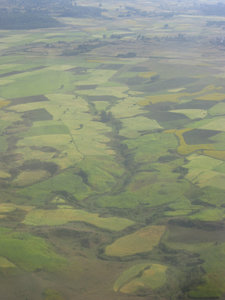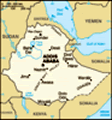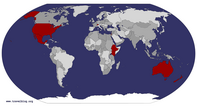Advertisement
Published: November 10th 2013

 Plane view
Plane view
Agricultural fields spanned almost the entire way between Addis and GondarWhen we arrive shortly after dawn at the Addis airport, luggage tickets and boarding passes await us. No waiting in line only to be told you’re in the wrong line and the rules changed but the signs didn’t and now you have to please hurry along because you need to be in the waiting area an hour ahead of time and nobody informed you previously of that rule either. (Sound familiar, world travelers?) Hmmm….there are perks to group travel!
In Ethiopian airports, like Kenyan ones, there is a security checkpoint at the front of the airport as well as the one entering the waiting area. We joke about needing two checkpoints just in case one metal detector or scanner isn’t working so well (these are very old-looking machines) but perhaps there’s something to be said for screening folks before they even enter the building. But of course, I see two foreign tourists leave their hiking boots on while going through the second checkpoint while I am firmly told to remove my wedges. Ach well.
The flight to Gondar takes all of an hour and I am glued to the window the entire time. I

 Decked out jeep
Decked out jeep
This was my favorite faux fur decorationdrink in the changing landscape and am quickly astonished at the sheer magnitude of the agriculture here. Almost the entire way up to Gondar has been carved into squarish fields that shift from one green hue to another. The landscape is gentle (from hundreds of feet above at least) the entire way with only a few cliff faces and rumpled hills to break the steady climb in elevation. Gondar is the heart of the Amhara Region, the traditional homeland of the people. It’s situated north of the placid and large Lake Tana, the origin of the Blue Nile. Flying over part of the shoreline, Lake Tana looks distinctly coppery in tone and I wonder if the soil is heavily clay-based.
The Gondar airport is a small one with only one plane landing at any given time. We walk across the tarmac and claim our baggage directly from the piles atop metal carts (no need for the moving belt here!) We split our large group into seven jeeps which the owners have decked out in brightly colored faux fur, along the dash and the steering column.
Our one tourist outing of the day takes us to Fasil Ghebbi or
Fasilides’ Castle. This is one of the most iconic tourist sites in all of Ethiopia (beyond the natural beauties). Fasilides was a seventeenth century Ethiopian emperor who claimed descent from Solomon (the Solomonic Dynasty was a key aristocratic distinction for millennia in Ethiopia). Fasilides broke with the tradition of a constantly roving court and built his impressive castle just ten years after he founded Gondar which was the capital of Ethiopia for several centuries afterward. As soon as we walk within the imposing stone walls of the historic site, we enter a different Ethiopian world. Many of the buildings are in ruin but the ruddy stone, verdant grasses, and plethora of birds bring an easy, gentle life back to the place. There are many sightseers here, foreign and not. Our tour guide for the next couple of hours tells good stories of each building and is most patient with our rambunctious group. Not for the first time (or the last) I am reminded of the phrase “herding cats.” Our group is decidedly hard to keep moving at any regular clip.
This World Heritage Site smoothly blends multiple cultures and architectural styles, chiefly Nubian, Arab, Indian, and Western European. Inside
the central structure, still mostly intact with multiple stories, crenellations and all, our guide points out what is to our group an especially interesting architectural flourish. Above the lintels in the males-only dining hall (the women’s is just on the other side, a tad smaller) and at regular intervals along a supporting wall are the Stars of David or Magen David. Since Fasilides claimed descent from the great King Solomon, the stars represented that lineage. It was not considered, in Ethiopia, a sign of the Jewish people. Fasilides was a staunch Orthodox Christian, which is still the dominant religion across Ethiopia. But many emperors proudly pointed to their (real or not) descent from Makeda, the child of King Solomon and the Queen of Sheba. The legend has never been confirmed by historical scholars, but it is definitely considered factual in Ethiopia.
Beta Israel, rediscovered and relocated Throughout the day our knowledge of the intricacies of Judaism and Jewishness in Ethiopia deepens. The stories are relevant to us beyond our shared passion for Jewish culture as these stories tie in with the JDC’s presence and activities within Ethiopia. In the mid 1900’s, Ethiopian Jewry was reconnected with the broader

 Star of David
Star of David
Can you see the Magen David carved in relief?Jewish world but controversy dogged that tribal reunion from the get-go. Ethiopian Jews had long been secluded within the rich highlands of Ethiopia, spread across 500 or so villages but only a relative pocket of Judaism tucked into a sea of Orthodox Christianity and to a lesser extent, Muslims. Because of that seclusion that stretched back into the ages (perhaps not long after Solomon’s time!), Ethiopian Jewish practices were strictly in keeping with the Torah (Bible) and not the rabbinical writings (Talmud) that shaped so much of other Jewish Diaspora practice, philosophy and culture in the Common Era. So when globalization started to transform the world, suddenly the Ethiopian Jewish community popped into view as a near relict of the past. The Israeli government was unsure of how to treat this community and not until 1977 was the Law of Return applied to Beta Israel, the Ethiopian Jews. And then there is the Falasha Mora community, a smaller group of Ethiopians who are Christians but claim their parents or grandparents (or even another generation or two back) were forced to convert from Judaism. Many of these folks wish to immigrate to Israel and self identify as Jews. But to no
avail (currently). While Beta Israel was airlifted en masse to Israel in two history-making operations, the Falasha Mora are not considered Jews by the Israeli gov’t and are still in Ethiopia, clamoring for legal validation.
However, the JDC removes itself from such controversy (as much as possible) and chooses to continue to provide services for the Falasha Mora as well as other Ethiopians, of whatever heritage or religious denomination, in its service areas. We view one of the 23 wells that the JDC has put into the Gondar region. The wells reduce the back-breaking labor of women who have to cart 10 or more gallons of water at a time over long distances for just home use. The wells likely also reduce disease and parasite transmissions from open contaminated waters. The JDC also has multiple education programs, mostly with respect to funding new school buildings but we will learn more about those in the next few days.
After the well, we go to another lesser-known historical site. A recent history site. Our last major stop for the day
is the Ambober Synaogue, a reconstructed building in a small village that used to mostly consist of Beta Israel. Manlio, the JDC Country Director, tells us that years ago, you would be greeted with “Shalom!” instead of “Salaam!” here. However, the synagogue has stood vacant for well over a decade now, likely closer to two. A culture has died out here. A religion has gone locally extinct. What a strange concept. This synagogue site feels in limbo, waiting to see if it too will vanish or be saved. Saved for what? For who? Will a monument or small museum here be worth it? Even the piles of Hebrew books we find in the synagogue are not historical artifacts but tokens left by other Jewish travelers in very recent years.
The synagogue is walled away, on a slight rise, in a very rural village where the buildings are all of twisted wood, some with tin roofs, more with thatched ones. The children and even teenagers follow us closely, reaching to hold our hands. Isaiah, our pied piper, plays his guitar and sings slowly and loudly, attracting quite the crowd. As we pile back into the jeeps, several little ones ask

 Teff
Teff
A highly useful and used grain and a very pretty grassus for water bottles which they reuse constantly.
On our way back, our group is a bit quieter, tired from the early morning but more so from the wealth of information and history handed to us today. I watch the landscape, as always, and by now the jeep driver has learned that I want to learn the name of the plants and crops we pass by. He points out the foamy delicate teff, the bright yellow flowers of Niger seed (used for oil and seed), the chest-high maize and sorghum, and the just-germinated chickpeas. The same crops repeat over and over in varying orders and field sizes. Young boys stand on elevated platforms in the fields to scare off marauding birds. Other young children herd small clusters of hardy, docile Boran cattle, a distinctive East African breed with large humps rising above their shoulders.
We make our way back to Gondar, through this large but still rural city, and to our hill-top hotel, secluded from the hustle and bustle. This hotel is decidedly posh, to me at least. Although, of course, even here, hot water is not guaranteed. Solar heating can be a pain in the
ass. But my roommate Jennifer and I lucked out and we got a room that always has plenty of hot water. Gradually we all wind down for the night, after a meal at the hotel and a group reflection session. We sign up for service events for the following day and then splinter off to our rooms (after a few songs at the piano in the dining room, that is).
Advertisement
Tot: 0.101s; Tpl: 0.013s; cc: 8; qc: 23; dbt: 0.0494s; 1; m:domysql w:travelblog (10.17.0.13); sld: 1;
; mem: 1.1mb


















